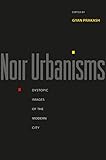Noir Urbanisms : Dystopic Images of the Modern City / ed. by Gyan Prakash.
Material type: TextSeries: Publications in Partnership with the Shelby Cullom Davis Center at Princeton University ; 3Publisher: Princeton, NJ : Princeton University Press, [2010]Copyright date: ©2011Edition: Course BookDescription: 1 online resource (288 p.) : 29 halftonesContent type:
TextSeries: Publications in Partnership with the Shelby Cullom Davis Center at Princeton University ; 3Publisher: Princeton, NJ : Princeton University Press, [2010]Copyright date: ©2011Edition: Course BookDescription: 1 online resource (288 p.) : 29 halftonesContent type: - 9780691146447
- 9781400836628
- 791.43/655 22
- PN1995.9.F54
- online - DeGruyter
- Issued also in print.
| Item type | Current library | Call number | URL | Status | Notes | Barcode | |
|---|---|---|---|---|---|---|---|
 eBook
eBook
|
Biblioteca "Angelicum" Pont. Univ. S.Tommaso d'Aquino Nuvola online | online - DeGruyter (Browse shelf(Opens below)) | Online access | Not for loan (Accesso limitato) | Accesso per gli utenti autorizzati / Access for authorized users | (dgr)9781400836628 |
Frontmatter -- Contents -- Introduction. Imaging the Modern City, Darkly -- Modernism and Urban Dystopia -- Chapter 1. The Phantasm of the Apocalypse -- Chapter 2. Sounds Like Hell -- Chapter 3. Tlatelolco -- The Aesthetics of the Dark City -- Chapter 4. A Regional Geography of Film Noir -- Chapter 5. Oh No, There Goes Tokyo -- Chapter 6. Postsocialist Urban Dystopia? -- Chapter 7. Friction, Collision, and the Grotesque -- Imaging Urban Crisis -- Chapter 8. Topographies of Distress -- Chapter 9. Living in Dystopia -- Chapter 10. Imaging Urban Breakdown -- Contributors -- Index
restricted access online access with authorization star
http://purl.org/coar/access_right/c_16ec
Dystopic imagery has figured prominently in modern depictions of the urban landscape. The city is often portrayed as a terrifying world of darkness, crisis, and catastrophe. Noir Urbanisms traces the history of the modern city through its critical representations in art, cinema, print journalism, literature, sociology, and architecture. It focuses on visual forms of dystopic representation--because the history of the modern city is inseparable from the production and circulation of images--and examines their strengths and limits as urban criticism. Contributors explore dystopic images of the modern city in Germany, Mexico, Japan, India, South Africa, China, and the United States. Their topics include Weimar representations of urban dystopia in Fritz Lang's 1927 film Metropolis; 1960s modernist architecture in Mexico City; Hollywood film noir of the 1940s and 1950s; the recurring fictional destruction of Tokyo in postwar Japan's sci-fi doom culture; the urban fringe in Bombay cinema; fictional explorations of urban dystopia in postapartheid Johannesburg; and Delhi's out-of-control and media-saturated urbanism in the 1980s and 1990s. What emerges in Noir Urbanisms is the unsettling and disorienting alchemy between dark representations and the modern urban experience. In addition to the editor, the contributors are David R. Ambaras, James Donald, Rubén Gallo, Anton Kaes, Ranjani Mazumdar, Jennifer Robinson, Mark Shiel, Ravi Sundaram, William M. Tsutsui, and Li Zhang.
Issued also in print.
Mode of access: Internet via World Wide Web.
In English.
Description based on online resource; title from PDF title page (publisher's Web site, viewed 29. Jul 2021)


